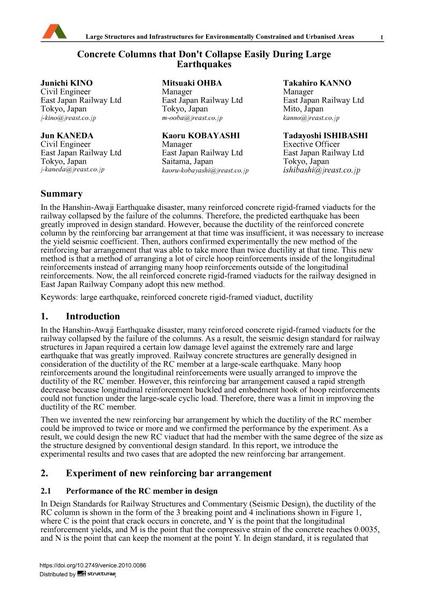Concrete Columns that Don't Collapse Easily During Large Earthquakes

|
|
|||||||||||
Bibliographic Details
| Author(s): |
Junichi Kino
Mitsuaki Ohba Takahiro Kanno Jun Kaneda Kaoru Kobayashi Tadayoshi Ishibashi |
||||
|---|---|---|---|---|---|
| Medium: | conference paper | ||||
| Language(s): | English | ||||
| Conference: | IABSE Symposium: Large Structures and Infrastructures for Environmentally Constrained and Urbanised Areas, Venice, Italy, 22-24 September 2010 | ||||
| Published in: | IABSE Symposium Venice 2010 | ||||
|
|||||
| Page(s): | 86-87 | ||||
| Total no. of pages: | 7 | ||||
| Year: | 2010 | ||||
| DOI: | 10.2749/venice.2010.0086 | ||||
| Abstract: |
In the Hanshin-Awaji Earthquake disaster, many reinforced concrete rigid-framed viaducts for the railway collapsed by the failure of the columns. Therefore, the predicted earthquake has been greatly improved in design standard. However, because the ductility of the reinforced concrete column by the reinforcing bar arrangement at that time was insufficient, it was necessary to increase the yield seismic coefficient. Then, authors confirmed experimentally the new method of the reinforcing bar arrangement that was able to take more than twice ductility at that time. This new method is that a method of arranging a lot of circle hoop reinforcements inside of the longitudinal reinforcements instead of arranging many hoop reinforcements outside of the longitudinal reinforcements. Now, the all reinforced concrete rigid-framed viaducts for the railway designed in East Japan Railway Company adopt this new method. |
||||
| Keywords: |
ductility large earthquake reinforced concrete rigid-framed viaduct
|
||||
